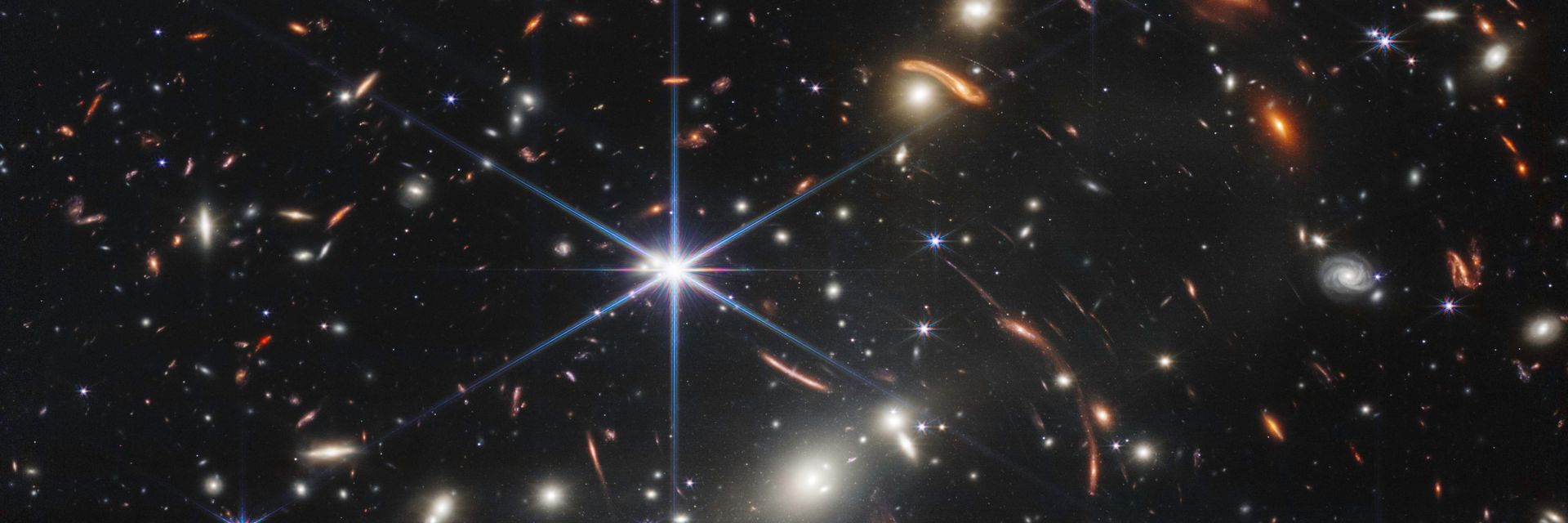The James Webb Space Telescope has graced observers on Earth with amazing images of the early Universe, never before seen in such detail. It promises even more discoveries.
◊
When the James Webb Space Telescope (JWST) lifted off from French Guiana’s Space Centre on December 25, 2021, there were, according to engineers on the project, 344 things that could have gone wrong; any one of the potential errors would have been cause to scuttle the entire project. These were called “single-point failures,” or SPFs. Two weeks later, when the Webb was well on its way to its target location, the last potential SPF – the deployment of the telescope’s final mirror wing – was “retired.” History’s most technologically advanced tool to explore the Universe had become fully and successfully operational.
Now, only a few months later, the JWST has gifted us with astounding images of objects from deep space viewable with more clarity than ever before, and in a different light – infrared. Infrared comprises wavelengths of light beyond the visible spectrum, allowing us to view objects and phenomena that have been invisible to us and to our cameras before.
Infrared light passes through gas and dust, which have blocked our full view of the heavens up to now. The images already produced by the Webb telescope are marvels, detailing early galaxies, star formation, and other celestial observations that track back to more than 13 billion years in the past, fewer than a billion years after the Big Bang. The night sky is indeed a gateway to a time machine.
For more on the JWST, check out the MagellanTV original documentary Planet Hunting with the James Webb Space Telescope.
A New View into the Cosmos
In addition to scintillating images, the JWST also collects spectroscopic data on objects it encounters. This information promises to reveal unprecedented evidence concerning any clues to life out in deep space. While the spectra of most early galaxies reveal the presence of hydrogen and helium, with traces of lithium, scientists are on the lookout for heavier elements such as metals that might reveal conditions hospitable to life on those exoplanets in the “Goldilocks zone” of habitability.
Already, one exoplanet – WASP-96 b – has been found to be encased in clouds of gaseous H2O, an exciting find roughly 1,150 light-years away. Just as intriguing is the August 25, 2022, revelation that Webb has photographed another exoplanet, WASP-39 b, that has been shown to contain carbon dioxide in its atmosphere. While neither exoplanet is thought to be a candidate for life itself, this discovery, a first, “bodes well for the detection of atmospheres on smaller, terrestrial-sized planets,” says Natalie Batalha, leader of the team investigating the findings.
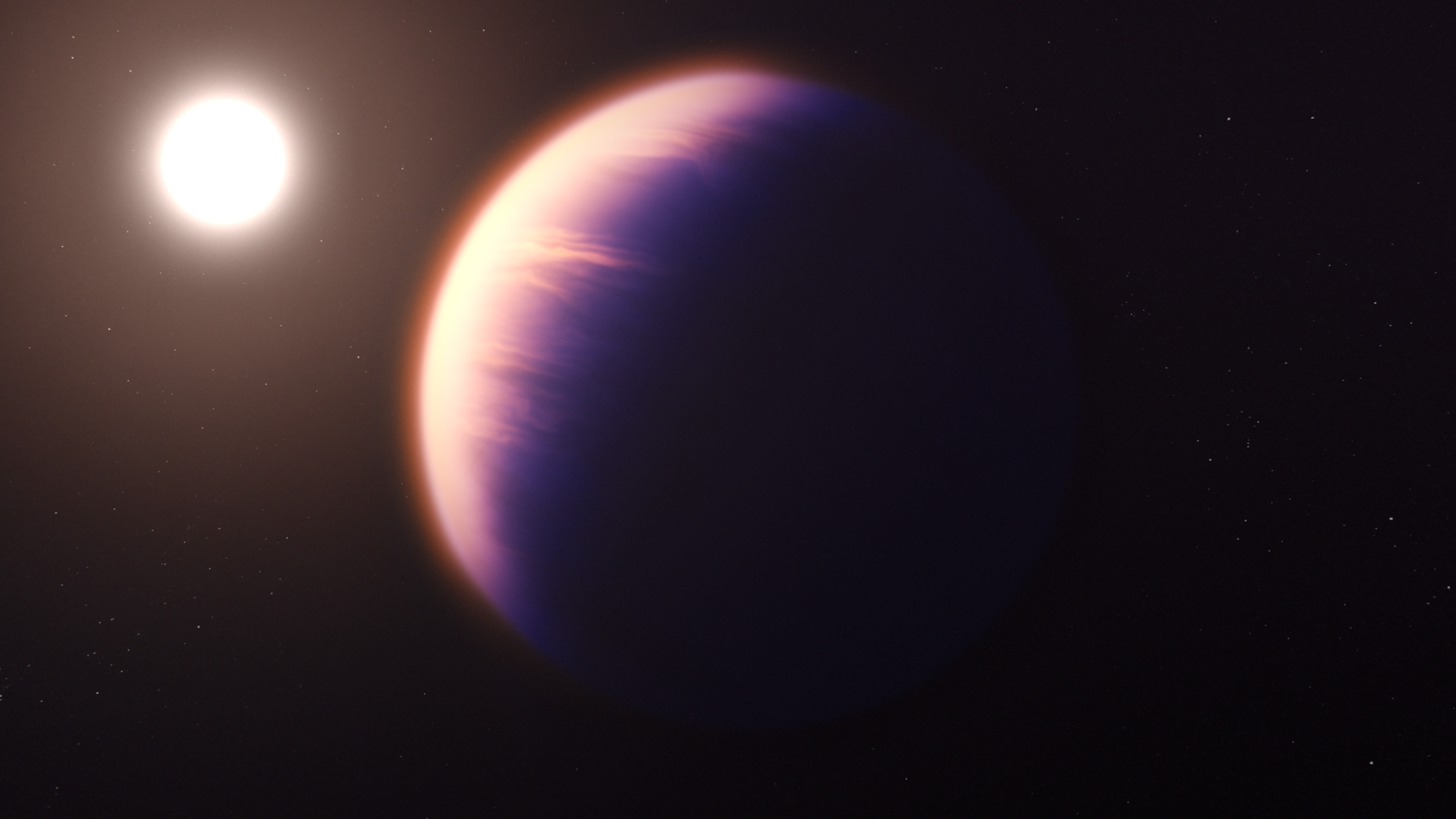
Exoplanet WASP-39 b, 700 light-years away, contains carbon dioxide in its atmosphere. Image by JWST. (Source: NASA/ESA/CSA/STScI)
A History of Delays and Cost Overruns Gives Way to A Surfeit of Success
In 2021, I wrote an article for MagellanTV that was partly about the problems the United States was having with the oft-delayed and enormously complex James Webb Space Telescope program. What a difference a year makes!
There’s no getting around the fact that the Webb telescope project was 10 years late and 1,000 percent over its initial budget. Originally planned to launch in 2012, and with a budget of $1 billion, the first project plan had to be completely scrapped between its initial stages in 1996 and 2011, when a new program director, Gregory Robinson, was brought in essentially to restart from scratch. This was something of a necessity, for earlier in that year Congress had threatened to cancel the entire program because of its rapidly escalating, unplanned cost. Eventually, the price tag rose to $10 billion.
Because of Webb’s rocky early history, I’m tempted to say that what transpired under the new program director was “lucky,” but what happened next was actually an extraordinarily agile, well-executed plan. The astronomers, who were directing the project’s scope and features, continually came up with new ideas to incorporate into the mission. These were sent to engineers, who were responsible for assessing the increasing complexity of the space telescope. Much of the needed technology was invented on the go to satisfy the need.
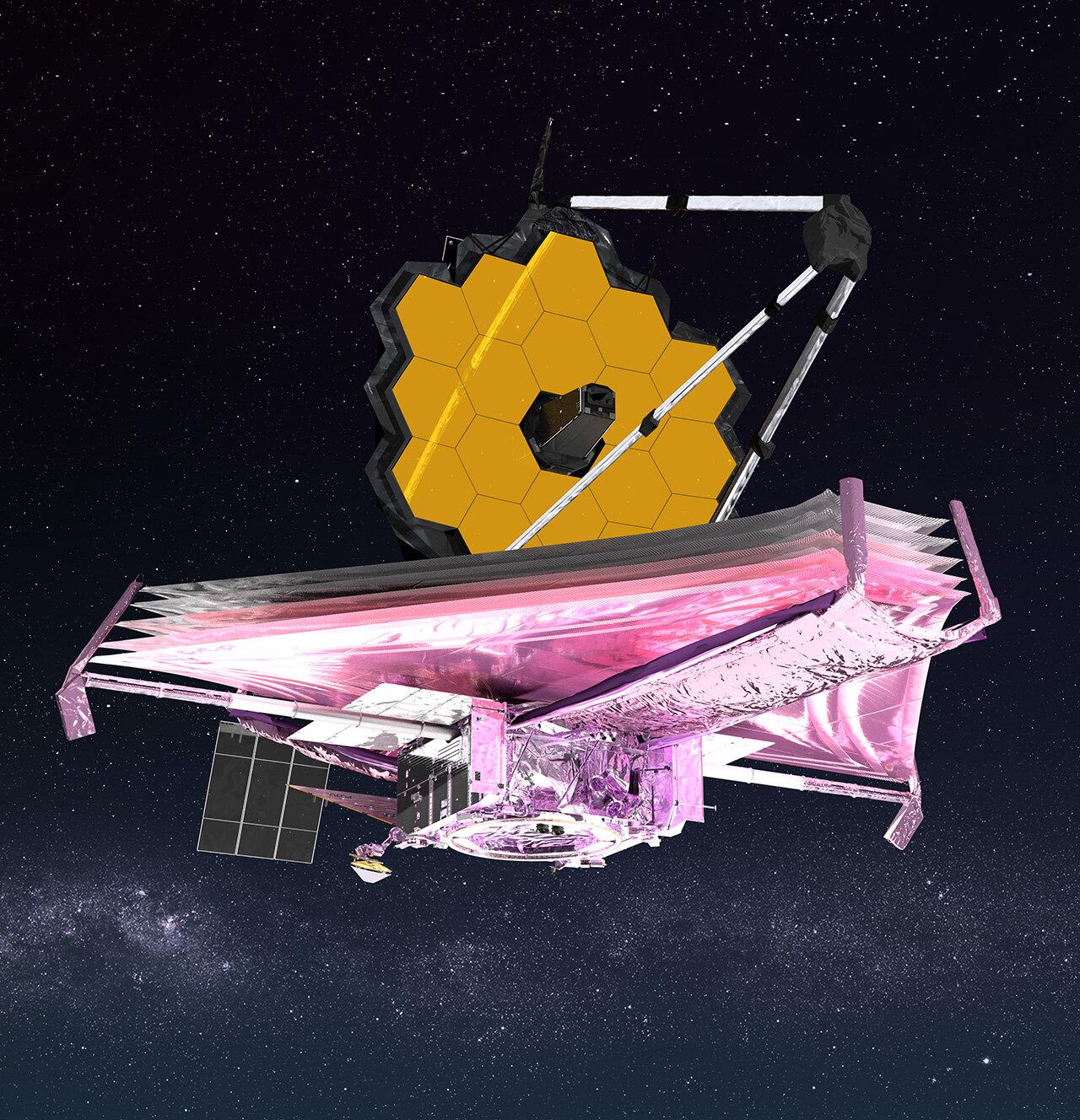
Artist’s conception of the James Webb Space Telescope in operation. (Source:NASA GSFC/CIL/Adriana Manrique Gutierrez)
For example, the JWST has a total of 18 finely adjusted hexagonal mirrors, and each one of them must be completely without imperfection to deliver the clearest synchronized images. To ensure that each one is as close to perfect as possible, a new tool needed to be invented to measure microscopic imperfections on the mirrors’ surfaces so they could be corrected prior to launch. This technology, developed expressly for the JWST, has found uses beyond the telescope and is now being employed by eye surgeons to make LASIK procedures more precise than ever.
The JWST’s Images Put the Hubble’s Work in the Rear Mirror
What the Webb telescope has produced so far, with its first crop of images, has astonished the world’s scientists as well as the public. Because of the telescope’s positioning, its array of mirrors, and its variety of cameras, we are now seeing objects in space with greater clarity and detail than even the images sent to Earth by the Hubble Space Telescope.
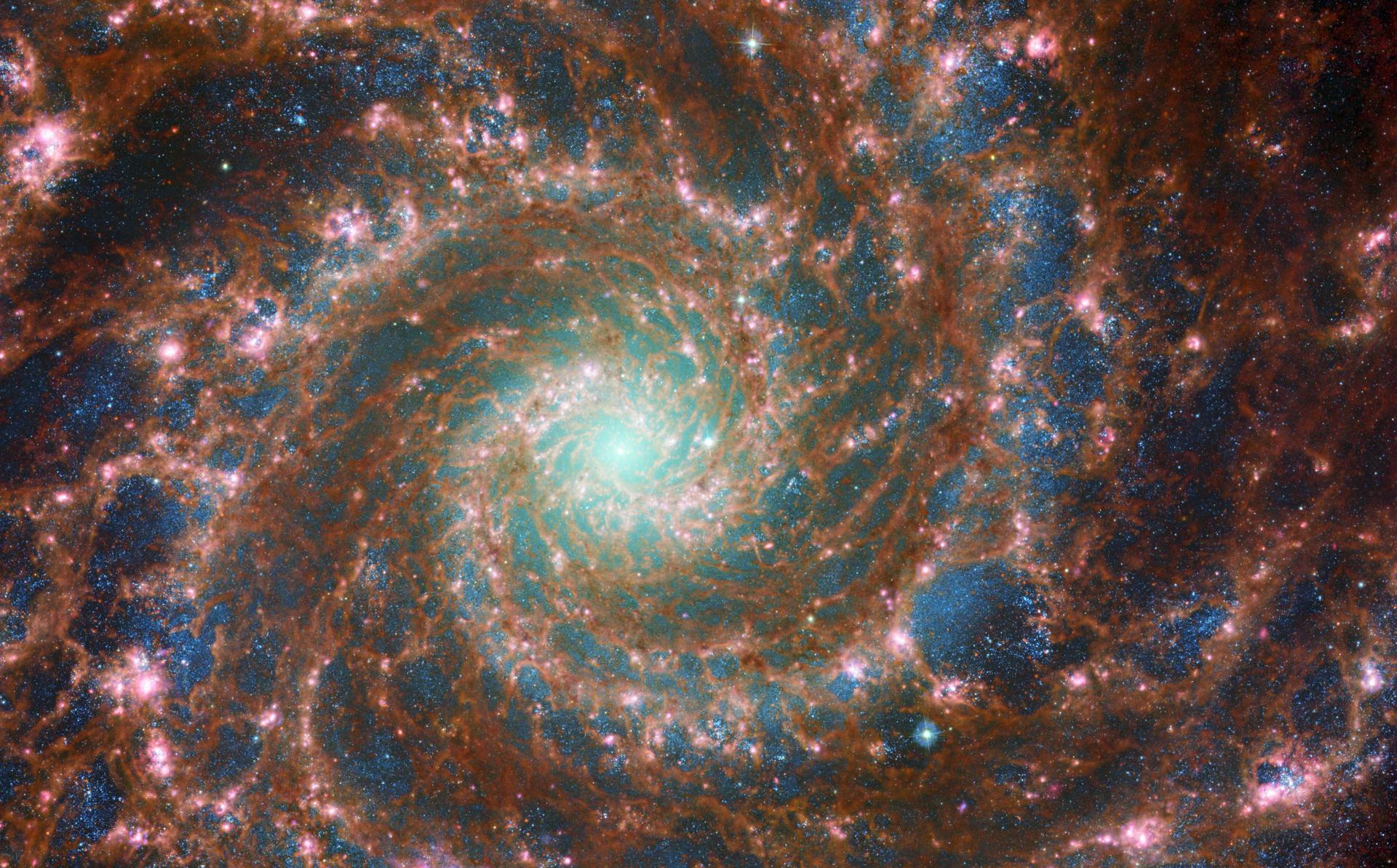
This Hubble/Webb hybrid image of the Phantom Galaxy, M74, displays the spiral galaxy with more detail than ever before. (Source: ESA/Webb, NASA & CSA, J. Lee and the PHANGS-JWST Team; ESA/Hubble & NASA, R. Chandar; Acknowledgement: J. Schmidt)
Hubble, of course, orbits the Earth, while JWST orbits the sun, a million miles away from Earth, at the second Lagrange point. Hubble’s cameras encompass ultraviolet, visible, and near-infrared spectra, while Webb’s cameras operate in the infrared spectrum. This is no swipe at Hubble, which has produced magnificent imagery and contributed to numerous advances in astronomy and astrophysics. And, as the image above demonstrates, there is potential for using both space telescopes to produce awe-inspiring images that could not be realized by one or the other alone.
The Webb telescope is a major leap forward for humankind’s interstellar vision. Just take a look at its image of Jupiter, released on August 22, 2022, to see what the telescope, assisted by scientific teams and even “citizen scientists,” can do.
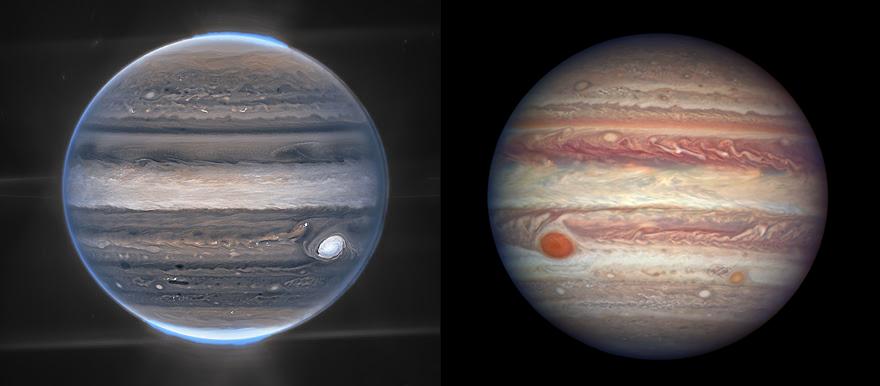
Image of Jupiter, at left, taken by Webb and image-processed by citizen-scientist Judy Schmidt (Source: NASA/ESA/CSA/STScI); Jupiter as seen through Hubble, at right. (Source: NASA, ESA, and A. Simon [NASA Goddard])
In Webb’s image, we can see the auroras, which appear at high altitudes at both poles of the gas giant. We can also clearly see Jupiter’s rings, which are virtually invisible from Earth. And Jupiter’s famous Red Spot now appears white, as it is reflecting bright light from the Sun. The citizen scientist involved, Judy Schmidt, created this image from a composite of several shots taken by the JWST over a brief span of time. In addition to “translating” the infrared scale into visible colors, Schmidt also had to adjust the separate images to get the fast-moving clouds above the planet to align.
As exciting an instrument as the Webb Space Telescope is, it will be only five years until it’s joined by an even more impressive unit, the Nancy Grace Roman Space Telescope, which is projected to be deployed in the skies by late 2026.
The result “sums up the science of our Jupiter system program,” in the words of Thierry Fouchet, a professor at the Paris Observatory who co-led the observations of Jupiter as part of Webb’s Early Release Science program. Jupiter’s chemistry, its planetary dynamics, the thin rings, and its moons, are all clear as we view this amazing image.
Webb Space Telescope Image of Cartwheel Galaxy Shows Impact of 2 Star Systems
If you want to see the result of a spectacular collision of two star systems on a galactic scale, you can hardly do better than this view of a star structure called the Cartwheel Galaxy. The cosmic megastructure (on the right in the photo below) is actually two galaxies that collided long ago. The structure features a galactic disc in the center with an enormous ring galaxy around it. Eventually, in hundreds of millions of years, the combination of the two galaxies will come to resemble a single, typical spiral galaxy.
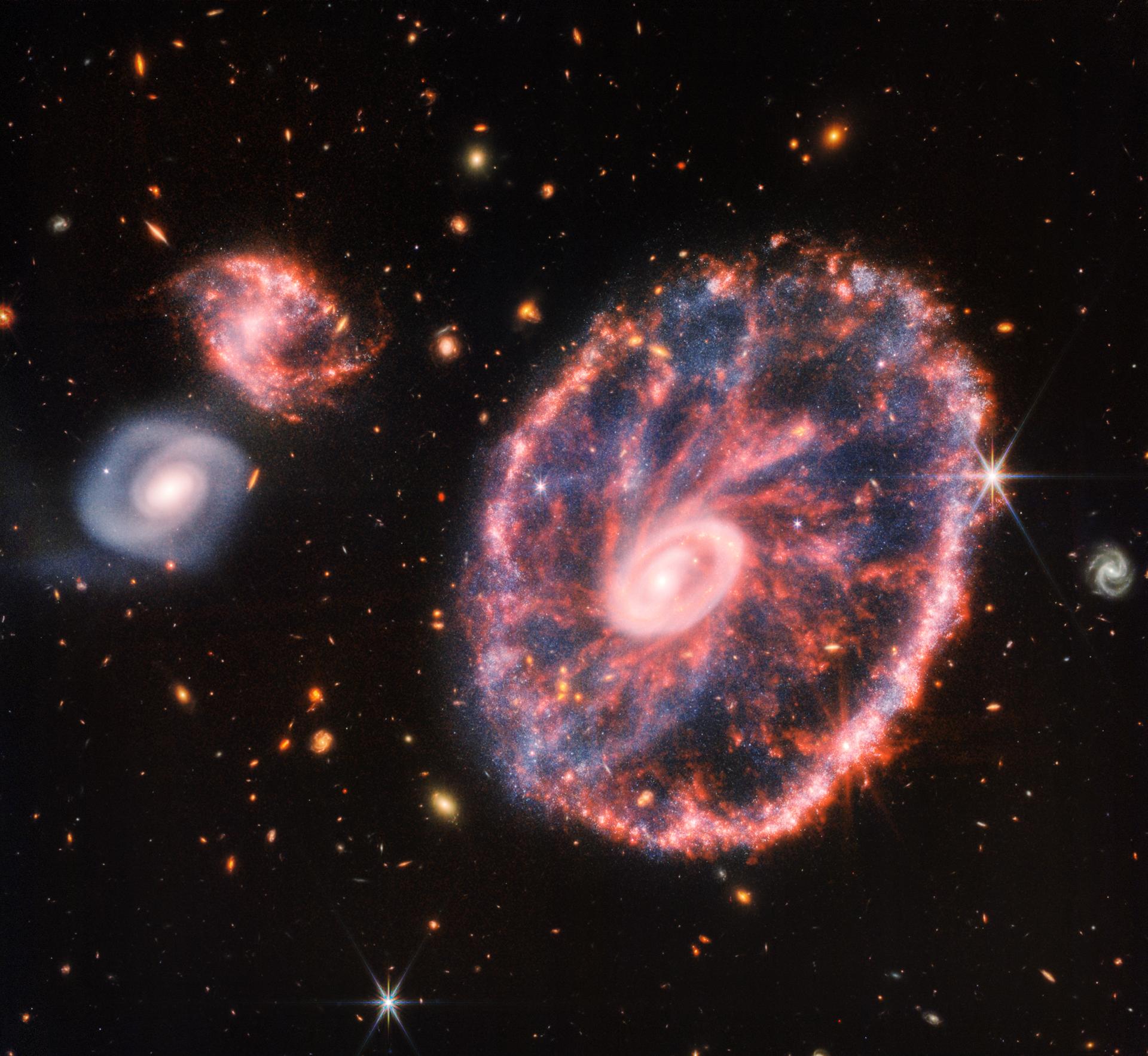 The Cartwheel Galaxy is nearly 490 million light-years from Earth. Image by JWST. (Source: NASA/ESA.CSA/STScI)
The Cartwheel Galaxy is nearly 490 million light-years from Earth. Image by JWST. (Source: NASA/ESA.CSA/STScI)
The JWST’s Near-Infrared Camera (NIRCam) reveals much more of this galaxy, and other galaxies surrounding it, than we’ve seen before. The blue dots in the photo reveal individual stars as well as pockets of star formation. Much work remains to be done to explore how the gas released by the explosive intersection of the two colliding galaxies gives rise to rich areas of star creation.
The Carina Nebula’s Mountainous ‘Cosmic Cliffs’ Show Effects of UV Radiation
Another dramatic image released in July 2022 shows a structure known as the “Cosmic Cliffs” of the Carina Nebula. In this remarkably detailed image, we see emerging stellar nurseries that were previously obscured by cosmic dust in the region. We are viewing the edge of a galaxy and its peaks – seven light-years tall – produced by ultraviolet radiation and stellar winds from young stars. Radiation is eroding the Carina Nebula’s wall, and the so-called pillars that remain are resisting the radiation. What appears to be steam in this image is actually ionized gas and dust caused by radiation.
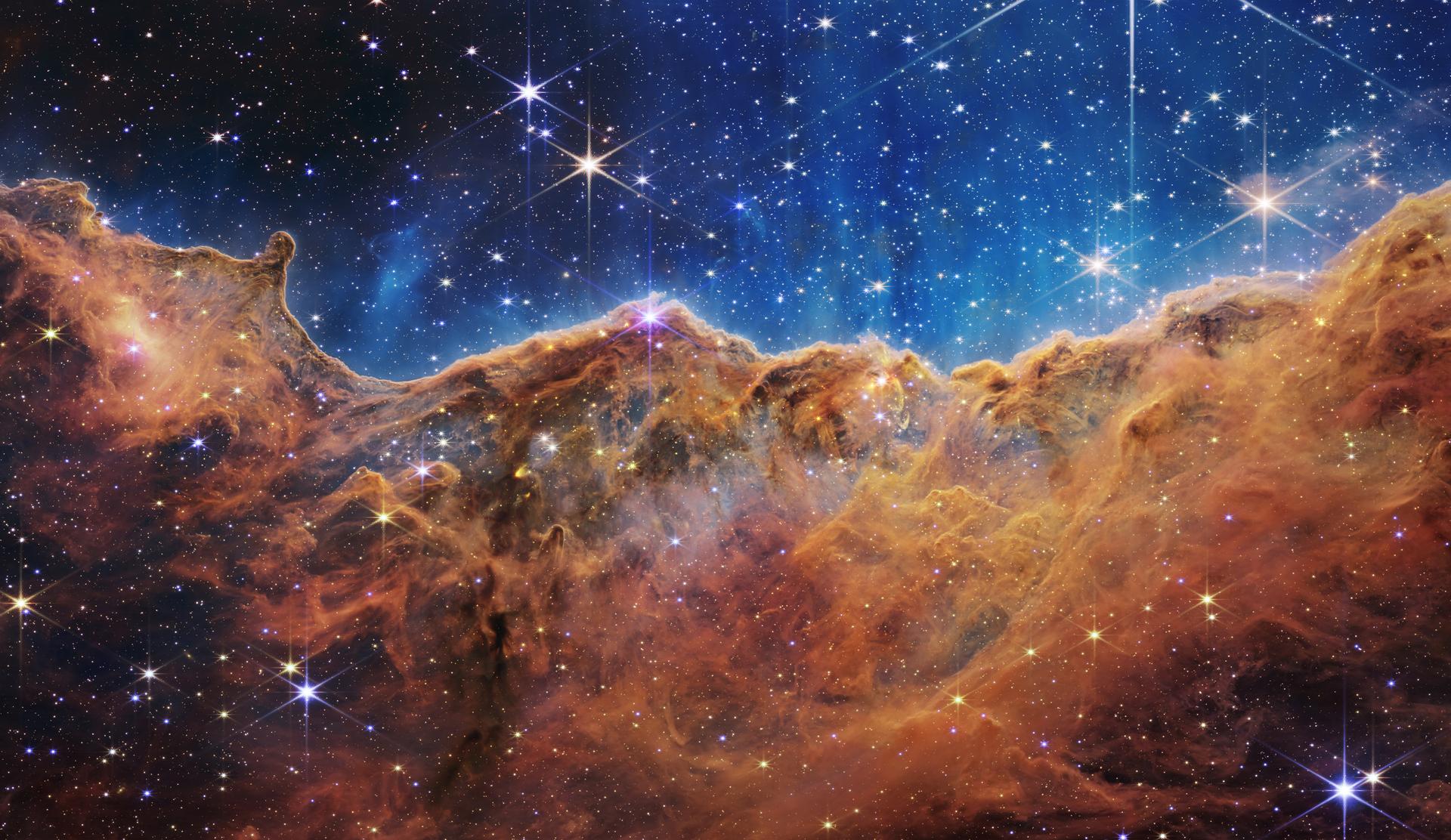 This image of the Carina Nebula, 7,500 light-years away, was captured by JWST in mid-2022. (Source: NASA/ESA/CSA/STScI)
This image of the Carina Nebula, 7,500 light-years away, was captured by JWST in mid-2022. (Source: NASA/ESA/CSA/STScI)
‘Stephan’s Quintet’ Reveals Converging Galaxies – As Seen in ‘It’s a Wonderful Life’
In the classic holiday film It’s a Wonderful Life, the angel who comes to Earth to help an unlucky man count his blessings is shown to come literally from the heavens, in this case the visible galaxy cluster that we know as Stephan’s Quintet. Discovered and named in 1877 by French astronomer Èdouard Stephan, this compact galaxy group contains four galaxies that are close together, at a distance of 290 million light-years from Earth. The galaxy that makes this grouping a quintet is, in fact, an optical illusion, as it’s only 40 million light-years away from us.
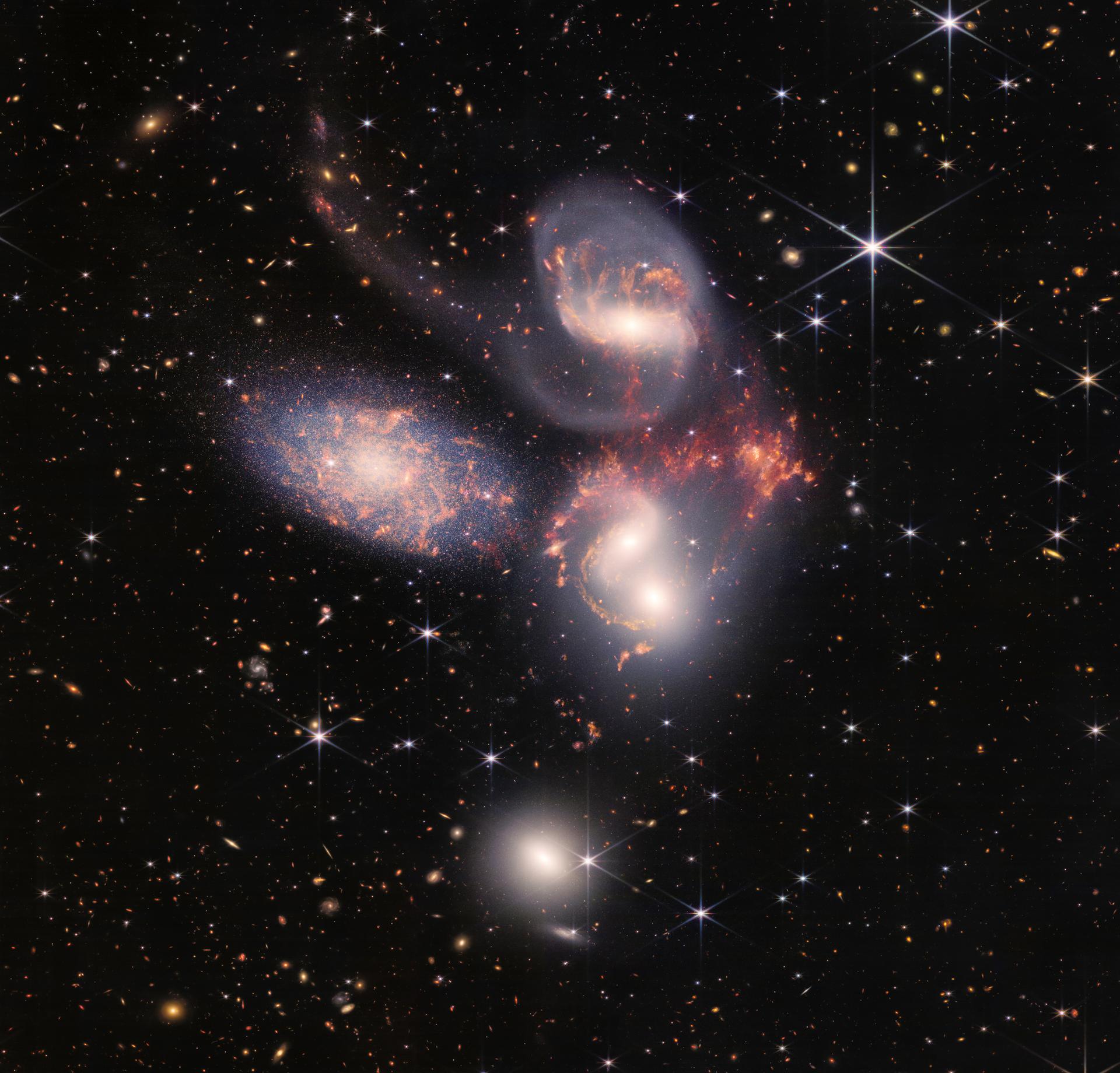 JWST image of Stephan’s Quintet. (Source: NASA/ESA/CSA/STScI)
JWST image of Stephan’s Quintet. (Source: NASA/ESA/CSA/STScI)
The topmost galaxy in this image contains a supermassive black hole – an “active galactic nucleus” – at its center. This black hole is a hard-to-believe 24 million times the mass of our Sun and radiates as much light energy as 40 billion Suns. The JWST captured hot gas outflows driven by the black holes at a level of detail beyond any other camera. In addition to containing a number of black holes, the motion of the four interacting galaxies produces many star-forming regions shown as fields of blue within the galaxies, particularly the one on the left in the image.
Dying Stars Reveal Stunning Details
The Southern Ring planetary nebula exhibits shells of gas and dust that have been ejected from a dying pair of stars. The binary star system’s unusual shape shows how the matter the stars ejected in their final stage transforms into massive structures in the sky. The images captured by the Webb telescope reveal the evolution of late-stage stars and how they transform their environments.
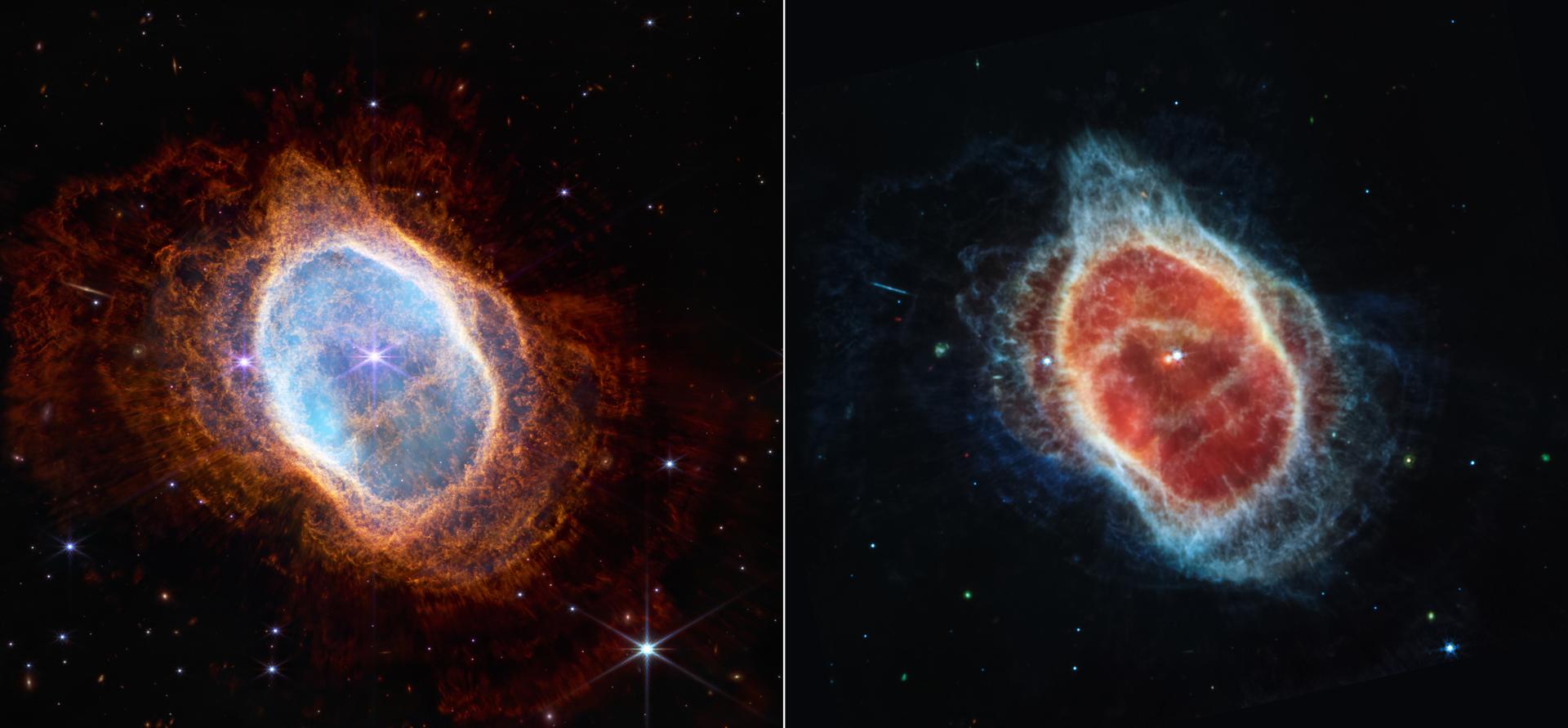
The nebula at left is captured by the Near-Infrared Camera (NIRCam), and at right by the Mid-Infrared Instrument (MIRI), a camera and spectrograph that shows details of the object. (Source: NASA/ESA/CSA/STScI)
The dying stars of the Southern Ring Nebula, 2,500 light-years from us, send out rings of gas and dust in all directions, transforming the shape of the local landscape.
A Promise of Even More Discoveries
As astounding as its images have been so far, the James Webb Space Telescope promises even more. In collecting observations from objects billions of light-years away along with spectrographic datasets, Webb is equipped to uncover secrets of the early Universe, reaching closer to its origins than we’ve been able to see previously, and in stunning detail.
We’ll be learning new information about how galaxies interact, how stars form, and, perhaps most revealingly, we may be able to pinpoint exoplanets in the Universe that could harbor life – or at least possess life’s building blocks. The future is suddenly more exciting, and we’re lucky to be part of it for as long as Webb keeps taking pictures to analyze and appreciate.
Ω
Kevin Martin is Senior Writer for MagellanTV. He writes on various topics, including outer space, the fine arts, and modern history. He has had a long career as a journalist and communications specialist with nonprofit and for-profit organizations. He resides in Glendale, California.
Title Image: JWST’s first Deep Field image (detail) (Source: NASA/ESA/CSA/STScI)
